Null Black and White theme by Major Zero
Download: NullBandW.p3t
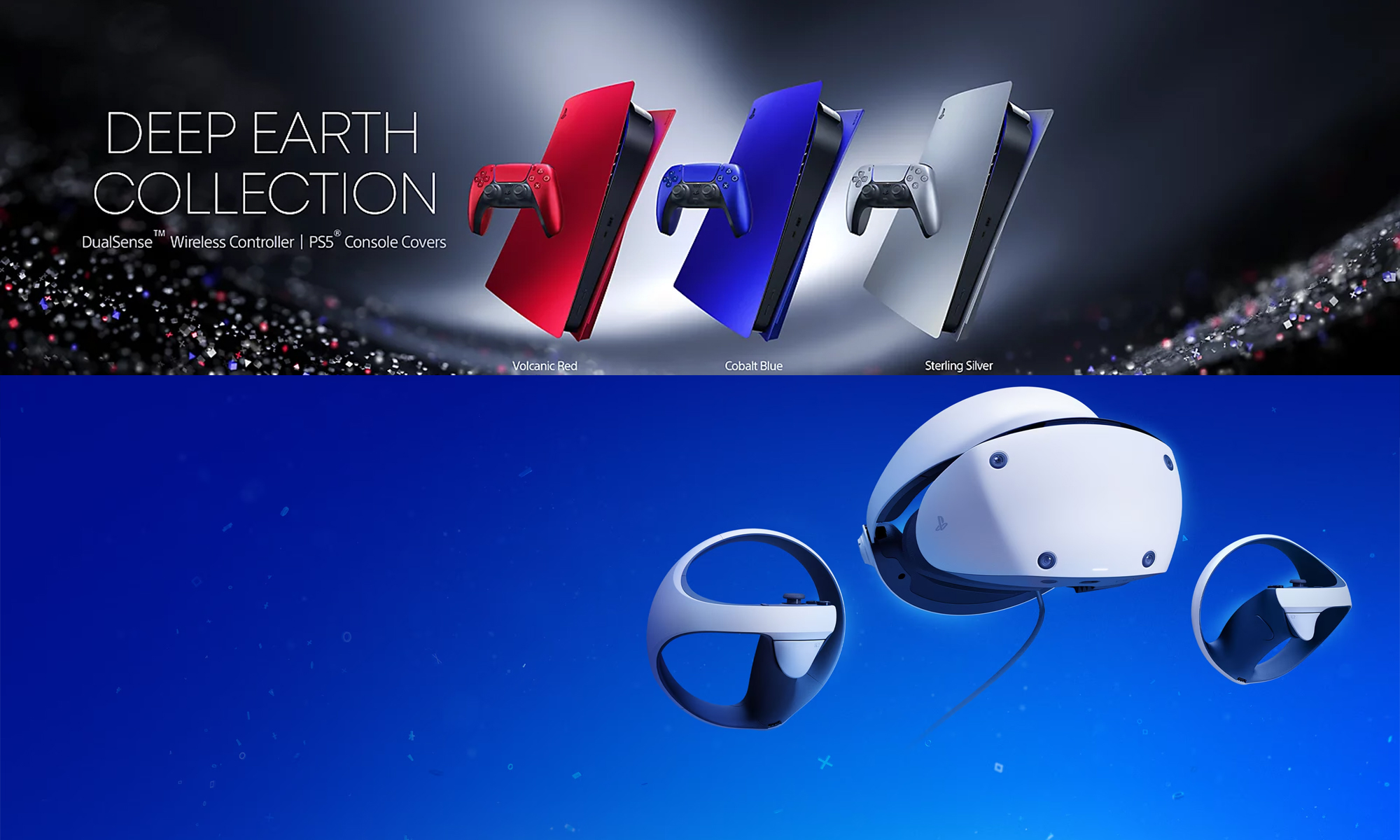
The #1 spot for Playstation themes!
Null Black and White theme by Major Zero
Download: NullBandW.p3t
Socom Confrontation theme by MurderPickle
Download: SocomConfrontation_4.p3t
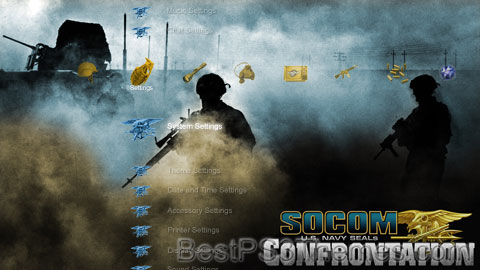
(1 background)
P3T Unpacker v0.12
Copyright (c) 2007. Anoop Menon
This program unpacks Playstation 3 Theme files (.p3t) so that you can touch-up an existing theme to your likings or use a certain wallpaper from it (as many themes have multiple). But remember, if you use content from another theme and release it, be sure to give credit!
Download for Windows: p3textractor.zip
Instructions:
Download p3textractor.zip from above. Extract the files to a folder with a program such as WinZip or WinRAR. Now there are multiple ways to extract the theme.
The first way is to simply open the p3t file with p3textractor.exe. If you don’t know how to do this, right click the p3t file and select Open With. Alternatively, open the p3t file and it will ask you to select a program to open with. Click Browse and find p3textractor.exe from where you previously extracted it to. It will open CMD and extract the theme to extracted.[filename]. After that, all you need to do for any future p3t files is open them and it will extract.
The second way is very simple. Just drag the p3t file to p3textractor.exe. It will open CMD and extract the theme to extracted.[filename].
For the third way, first put the p3t file you want to extract into the same folder as p3textractor.exe. Open CMD and browse to the folder with p3extractor.exe. Enter the following:
p3textractor filename.p3t [destination path]Replace filename with the name of the p3t file, and replace [destination path] with the name of the folder you want the files to be extracted to. A destination path is not required. By default it will extract to extracted.filename.
Sonic Unleashed theme by hulk0408
Download: SonicUnleashed.p3t
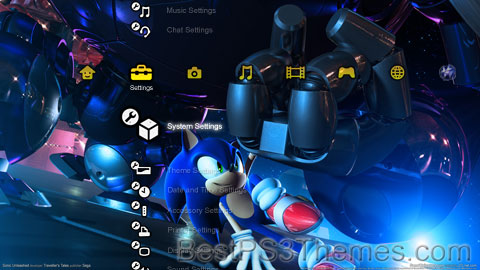
(2 backgrounds)
| Sonic Unleashed | |
|---|---|
 | |
| Developer(s) | Sonic Team[a] |
| Publisher(s) | Sega[b] |
| Director(s) | Yoshihisa Hashimoto |
| Producer(s) | Akinori Nishiyama |
| Designer(s) |
|
| Programmer(s) |
|
| Artist(s) |
|
| Writer(s) | Kiyoko Yoshimura |
| Composer(s) |
|
| Series | Sonic the Hedgehog |
| Platform(s) | |
| Release | |
| Genre(s) | Platform, action-adventure, beat 'em up |
| Mode(s) | Single-player |
Sonic Unleashed[c] is a 2008 platform game developed by Sonic Team and published by Sega as part of the Sonic the Hedgehog series. The plot follows Sonic as he attempts to restore the world after his nemesis Doctor Eggman shatters it with a powerful laser to unleash Dark Gaia, an ancient evil which periodically transforms Sonic into a werewolf form (dubbed a "Werehog"). Gameplay features two distinct styles: daytime stages incorporate Sonic's traditional platforming and trademark speed; while night-time stages see Sonic transform into the Werehog and engage in slower combat against waves of enemies using the Werehog's brute strength.
The game's development began in 2006, after the creation of its game engine, the Hedgehog Engine. It was initially conceived as a sequel to Sonic Adventure 2 (2001), but developer Sonic Team began to introduce enough new innovations that separated it from previous games, and it was renamed Sonic World Adventure in domestic markets. The Werehog gameplay was conceived to help introduce newer gamers unfamiliar with the Sonic franchise to the series and is what influenced the use of Unleashed as a subtitle for western markets. The game's existence was first brought to light when Sega trademarked the Unleashed name in March 2008, and shortly after, images and a gameplay video were leaked. Three versions of the game were developed: one by Sonic Team for high definition consoles such as the Xbox 360 and PlayStation 3, one by Sonic Team and Dimps for standard definition consoles such as the Wii and PlayStation 2, and one by Gameloft for mobile phones. The game was released worldwide in 2008.
Public anticipation for Sonic Unleashed was high, as video game journalists saw it as a possible return to Sonic's platforming roots. While it was commercially successful, selling 2.45 million units, initial critical reception was mixed. Reviewers praised certain elements, such as the sense of speed in daylight stages and the graphics and audio that make up the environments, but criticized others, such as the Werehog game mechanic, as well as several gameplay and design concepts; many felt Unleashed was not the game to reinvigorate the series. Sonic Unleashed was delisted from retailers in 2010, following Sega's decision to remove all Sonic games with below-average Metacritic scores from sale.[2] Despite this, the PlayStation 3 version was relisted in April 2014 and added to PlayStation Now in March 2017, while the Xbox 360 version was relisted and made backward compatible for Xbox One in November 2018.[3]
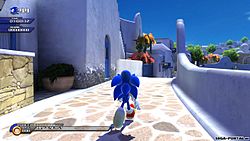
Sonic Unleashed is a platform game in which the player controls the titular Sonic the Hedgehog in two modes: fast-paced levels that take place during daytime, showcasing and using Sonic's trademark speed as seen in previous games in the series, and slower, night-time levels, during which Sonic transforms into the Werehog, and gameplay switches to an action-based, brawler style of play, in which Sonic battles Gaia enemies (those created by the main enemy in the game, Dark Gaia).[4][5] Each level takes place on a particular continent, each of which is based on a real-world location.[1] In sections of the Xbox 360 and PlayStation 3 versions of the game, the player may choose to advance the time of day in order to play as either Sonic or the Werehog; in the Wii and PlayStation 2 versions, time is advanced automatically.[6]
Daytime levels focus on Sonic's speed, and to this extent, sees the player control Sonic through fast-moving stages containing both 2D and 3D styles of gameplay.[7] 2D sections are reminiscent of the Mega Drive/Genesis-era Sonic games where the player controls Sonic in a side-scrolling fashion,[8] while 3D sections see the camera placed behind Sonic so the player may move in all directions. In addition to moves available in past games, such as the Homing Attack,[9] new moves are also introduced. For instance, a new sidestep feature known as the Quick Step is available, allowing Sonic to dodge left and right, and a Drift feature, which allows Sonic to make tighter turns without slowing down.[9] The game also features a gameplay mechanic previously used in the Sonic Rush series called the Sonic Boost, which greatly increases Sonic's speed, allowing him to smash through objects, destroy enemies instantly, or even access different level paths.[10] In the Xbox 360 and PlayStation 3 versions, an on-screen "Ring Energy" meter displays how much Boost is available.[10] The amount of Boost remaining may be increased by collecting more rings, and is decreased by using the Boost.[10] In contrast, the Wii and PlayStation 2 versions of the game represent available Boost using bars, which may be added by performing "Action Chains", destroying multiple enemies in quick succession through the use of homing attacks, or by collecting rings. Japanese game company Dimps helped design some of the stages.[11][12]
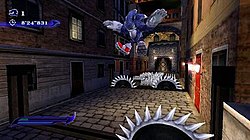
Night-time levels are slow-paced and action-oriented, while also featuring simple puzzle elements.[13] Gameplay focuses on Sonic's new "Werehog" form, which gives him great strength and stretchable arms. As the Werehog, the player can cling to distant objects, move items around and perform combo attacks to defeat enemies and advance through the level.[14] Collecting rings replenishes the Werehog's health,[8] while a special move, Unleashed Mode, allows him to channel his energy into increasing the power of his attacks for a short time.[15] Night-time levels are adjusted in the Wii version to allow greater use of the Wii Remote, such that players may control the arms of the Werehog by using the Wii Remote and Nunchuk in order to grab onto objects and proceed in the levels.[6] The Wii version also expands upon the ratio of night-time levels to daytime, with more than three times as many night-time levels (twenty-five in all).[16] After night-time levels are completed, Dark Gaia Points are gained, allowing access to bonus moves.
In addition to these two gameplay types, Sonic Unleashed also features hub worlds, in which the player may reveal, as well as advance, the story of the game.[14] Hubworlds operate differently depending on the version of the game being played; the PlayStation 3 and Xbox 360 versions feature fully interactive, explorable 3D hub worlds, similar to those in Sonic the Hedgehog and Sonic Adventure, in which townspeople may be interacted with and side quests may be undertaken, in order to gain experience or unlock items, such as artwork, videos and music tracks.[14][8] In contrast, the Wii and PlayStation 2 versions feature menu-based map systems, in which players simply click on areas to talk to townspeople and find information.[6] Within both day and night-time levels are medals that Sonic may collect, two types of which exist: Sun and Moon.[10] In the Xbox 360 and PlayStation 3 versions, collecting these medals allows the player to level up Sonic's Sun and Moon stats, and these must be increased to reach new stages in the game, with a certain number of Sun Medals for Hedgehog levels, and a certain number of Moon Medals for Werehog levels.[10] Because only the Xbox 360 and PlayStation 3 versions feature playable hubworlds, these are also the only versions in which Sun and Moon Medals may be found by exploring the towns, talking to the citizens, and completing side quests.[10] In the Wii and PlayStation 2 versions, Sun and Moon Medals are earned after completing stages and clearing their objectives. The medals are used to open up doors in Gaia gates, which can earn bonus content.
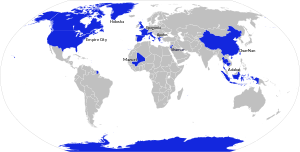
In a cold open, Sonic is pursuing his nemesis, Doctor Eggman, bounding around a fleet of spaceships. After the defeat of several of his robots, Sonic transforms into Super Sonic and corners Eggman on the main spaceship.[17] However, Eggman traps the hedgehog using the energy field of a powerful new ray weapon called the Chaos Energy Cannon, which forcefully reverts him to his normal state and removes the Chaos Emeralds out of him as well as their power,[1] causing them to turn grey and useless. He then uses the Emeralds' energy to fire an enormous laser and unleash a powerful beast, Dark Gaia,[18] from the center of the planet, which has devastating consequences, shattering the planet into seven pieces.[17][18] In addition, the process has the unforeseen side-effect of transforming Sonic into a "Werehog" — a beast form that loses speed but gains greater strength and abilities — at night.[19][20] Eggman ejects Sonic into space, who then lands safely onto the planet below thanks to a strange green shield.
After landing along with the Emeralds, Sonic encounters a friendly creature who appears to suffer amnesia.[21] Assuming he has caused it with his fall,[21] Sonic decides to assist him in his quest to find out who he is, and the creature becomes a guide for Sonic;[17] he then gives him the nickname "Chip".[22] Sonic's quest begins, and with the help of some old friends, such as Amy and Tails,[16] he attempts to solve the crisis by traveling the world's continents, finding Gaia Temples that will restore the Emeralds' power, in order to return the world, and himself, to normal.[1]
After six out of the seven continents are returned to normal, Chip is able to regain his memory; he is in fact Dark Gaia's opposite, Light Gaia.[23] Since the beginning of time, the two of them had been in a cycle where Dark Gaia would break the planet apart, and Light Gaia would put it back together.[24] Chip was released along with Dark Gaia, but because both of them were released prematurely, he lost his memory, and Dark Gaia was broken apart.[25] They are able to place the last Chaos Emerald in the shrine on the final continent at Eggman's new empire, "Eggmanland", but are interrupted by him;[26] Sonic then defeats Eggman who is using a robot that utilizes Dark Gaia's power, the Egg Dragoon. During the battle, the three sink into the core of the Earth and encounter Dark Gaia. Eggman orders Dark Gaia to destroy Sonic, but it turns on him, knocking him away with one of its tentacles, and absorbs the power that turned Sonic into a Werehog, curing Sonic of lycanthropy.[27]
Dark Gaia then attacks Sonic and Chip, but Chip protects Sonic and calls all of the Gaia temples together to form the Light Gaia Colossus and fight Dark Gaia.[28] The Gaia Colossus seemingly destroys Dark Gaia, but Dark Gaia is not finished with them or the Earth yet, and consumes the entire world in darkness, becoming Perfect Dark Gaia in the process. Chip then gives the restored Chaos Emeralds to Sonic, allowing him to turn into Super Sonic and continue their fight, until he finally destroys it; Dark Gaia sinks back into the planet, but the battle takes its toll on Super Sonic. Chip saves Sonic by throwing him to the surface, before returning himself to the inside of the planet; he leaves behind his necklace and some parting words. Sonic places the necklace on his hand as a bracelet to remind him of their adventure together before speeding off with Tails, flying alongside him on the coastline in the Tornado plane.[29]
Sonic Team began development of the game in 2006, after having begun work on the core technology, the Hedgehog Engine, in 2005.[30] The title Sonic Unleashed was trademarked by Sega on March 12, 2008.[31] Screenshots of cutscenes, artwork, and a video were leaked ten days later,[31] with the title confirmed by Sega on April 3, 2008[32] with a small selection of screenshots and an updated video. The game was developed internally by Sonic Team in Japan.[33] It was originally intended to be the third installment of the Sonic Adventure series[34] and subsequently, at an early development stage, had the working title Sonic World Adventure, complete with a work-in-progress logo. However, the development team began to introduce enough new innovations to separate it from the Sonic Adventure games,[35] and so a new title, Sonic Unleashed, was decided.[36] It was then later revealed that the game's name in Japan would in fact remain Sonic World Adventure for its release there.[1]
Sonic Team decided early on in the development process to reduce the number of characters present in the game, as well as to make Sonic the only playable character; this decision was taken to get more quality out of fewer characters.[37] While it felt that these ideas combined with traditional Sonic gameplay was a good beginning, it also had to consider how to introduce newer gamers unfamiliar with the Sonic franchise to the series, and so the concept of the Werehog was born, in addition to exploring its own mythology and ideas for the story.[37] Director Yoshihisa Hashimoto felt from the outset that there would be both praise and criticism, but hoped that long-term Sonic fans would understand and empathise with the ideas and direction the team had taken.[37] The game's human non-player characters were designed by Japanese artist team Gurihiru.[38][39]
In terms of technology, Hashimoto remarked that the visual style was born out of desire to see a global illumination solution used for the game's lighting — that is, light reflecting from one object in the scene onto others.[37] To this extent, development on the renderer for this process began, and the final solution allowed the developers to use distributed rendering over hundreds of computers to calculate lighting for each ten- to twenty-kilometer action stage in around two or three days.[37] Characters, enemies and objects are then lit at run-time with Sonic Team's "Light Field" technology to blend them in with the surrounding pre-calculated lighting.[37] Because the game was being developed for two levels of hardware capability depending on the target platform, two development "silos" were set up to work on two separate builds of the game: one for the Xbox 360 and PlayStation 3 version utilizing the Hedgehog Engine, and one for the Wii and PlayStation 2 version, which instead utilizes a modified version of an existing, internal Sega engine.[40] Hashimoto, who had never directed a Sonic game before,[35] incorporated new features such as a "Quick Step" mechanic allowing players to dodge obstacles with the L and R triggers.[41] Hashimoto sought to combine the best qualities of 2D and 3D Sonic gameplay[35] and address the criticisms directed at previous 3D entries in the franchise.[41] Additional code to dynamically adjust the speed of the game for different situations was used to properly balance its fast pace with traditional platforming elements.[41]
As well as the unique motion-based gameplay mechanics, the Wii version of the game also supports the GameCube controller, and also the option of using the Classic Controller.[17] The daytime levels for the Wii were altered to accommodate the motion control-based boost mechanic,[42] while night-time levels include a mostly behind-the-back view and different platforming styles and combat mechanics.[6] Developer Dimps, who had past involvement in the Sonic franchise, was involved in the design of the daytime areas for these versions.[12] In addition, overall, the Wii and PlayStation 2 versions have fewer daytime levels than the Xbox 360 and PlayStation 3 counterparts.[14]
Initially, it was stated that Unleashed was to be intended solely as a single-player experience, and would not offer any multiplayer or online modes. This was cast into doubt when references to online modes were alluded to around E3 2008,[43] but later interviews re-iterated that Unleashed would have no online modes at all.[18] However, downloadable content, including additional levels, would remain a possibility after the game's release.[18]
Sonic Unleashed was released for PlayStation 2, Wii and Xbox 360 on November 18, 2008, in North America, and on November 27 and November 28, 2008, in Australia and Europe, respectively.[44][45][46] The PlayStation 3 version was released a month later on December 9 in North America, on December 18 in Australia, and on December 19 in Europe.[47][48] In Japan the Wii version was released on December 18, 2008, with the Xbox 360 and PlayStation 3 versions releasing next year, on February 19, 2009.
A demo version was released on the Xbox Live Marketplace on December 8, 2008[49] and on the US and EU PlayStation Stores on December 18 and 24, 2008, respectively. The demo does not contain any of the Werehog stages.[49] On March 12, 2009, Sega released Sonic Unleashed's first downloadable content for the Xbox 360 and PlayStation 3, consisting of four Chun-nan daytime stages and two night stages in addition to two new missions. Since then, more downloadable levels have been added: Spagonia, Holoska, Mazuri, Apotos, Shamar, Empire City and Adabat.[50]
Speaking after the game's release, Sonic Team member and Sonic and the Black Knight producer and director Tetsu Katano remarked that although he did not feel the Werehog concept was a mistake, time and resources were a limiting factor in the game's production. He also remarked that the Werehog may reappear in future games, or possibly in a sequel to Sonic Unleashed, should one be made.[51]
Game developer Gameloft announced in May 2009 that it had secured a licensing agreement with Sega Europe Ltd. to produce Java versions of Sega properties, and that its first game would be a version of Sonic Unleashed for mobile phone platforms. It was released in June 2009 in Europe, Middle East, Australia and New Zealand.[52][53] The mobile version of Sonic Unleashed is strictly a side-scroller reminiscent of the original Genesis games, featuring new level designs and character abilities.[54]
The game's soundtrack, Planetary Pieces: Sonic World Adventure Original Soundtrack, was released as a three-disc set in Japan on January 28, 2009.[55] The vocal theme track, "Endless Possibility", written by longtime Sonic game composer Tomoya Ohtani, features Jaret Reddick of the American rock band Bowling for Soup.[56] The ending theme music for the game is a slow tempo ballad, "Dear My Friend", and features singer Brent Cash.[citation needed]
| Aggregator | Score |
|---|---|
| Metacritic | 66/100 (Wii/PS2)[57][58] 60/100 (X360)[59] 54/100 (PS3)[60] |
| Publication | Score |
|---|---|
| 1Up.com | C (X360)[61] D (Wii)[62] |
| Eurogamer | 6/10 (Wii)[6] 4/10 (X360)[63] |
| G4 | |
| Game Informer | 6.5/10 (Wii)[64] 6/10 (X360/PS3)[65][66] |
| GameSpot | 7/10 (Wii)[68] 3.5/10 (X360/PS3)[69] |
| GamesRadar+ | |
| GamesTM | 5/10 |
| GameTrailers | 7/10 (Wii/X360)[70] |
| IGN | 7.2/10 (Wii)[7] 7/10 (PS2)[71] 4.5/10 (X360/PS3)[72] |
| Nintendo Life | 6/10 (Wii)[75] |
| Nintendo Power | 8/10 (Wii) |
| Nintendo World Report | 4/10 (Wii)[74] |
| Official Nintendo Magazine | 79% (Wii)[16] |
| Official U.S. PlayStation Magazine | 4/10 |
| Official Xbox Magazine (US) | 6.5/10[73] |
| VideoGamer.com | 6/10[14] |
Initial anticipation when the first media for Unleashed was revealed was high, as the demonstration videos hinted at a possible return of Sonic to his traditional platforming roots, especially because of the series' declining quality in recent years,[76] and a number of poorly received games in the franchise that preceded it, such as the 2006 game, Sonic the Hedgehog.[76]
Sonic Unleashed received "mixed or average" reviews, with Metacritic aggregate scores of 60 and 54 out of 100 for the Xbox 360 and PlayStation 3 versions respectively, and 66 out of 100 for the Wii and PlayStation 2 versions.[58][57][59][60] The added element of motion controls for the Werehog sections, as well as text-based hub worlds and better Werehog level design and camera system, were reasons cited for the higher review scores for the Wii and PlayStation 2 versions of the game,[6][64] though a few review websites, such as 1UP, gave the Wii version a lower score than its Xbox 360 and PlayStation 3 counterparts.[61][62] Nevertheless, the game was a commercial success and sold 2.45 million units combined making it Sega's third bestselling game during their last fiscal year period of 2008.[77]
Positive elements of Sonic Unleashed remarked upon by reviews include the environments, such as the "postcard-perfect architecture",[61] and the graphics, with stages looking "absolutely gorgeous"[6
Winter Wonderland theme by Rainstorm81
Download: WinterWonderland.p3t
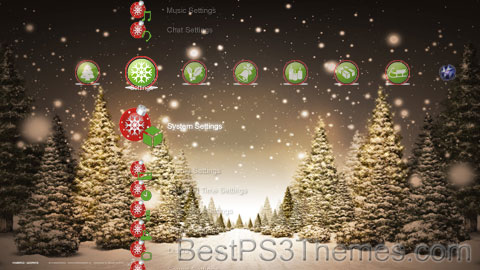
(10 backgrounds)
| "Winter Wonderland" | |
|---|---|
 1934 sheet music cover | |
| Song | |
| Published | 1934 by Bregman, Vocco and Conn |
| Genre | Christmas |
| Composer(s) | Felix Bernard |
| Lyricist(s) | Richard Bernhard Smith |
"Winter Wonderland" is a song written in 1934 by Felix Bernard and lyricist Richard Bernhard Smith. Due to its seasonal theme, it is often regarded as a Christmas song in the Northern Hemisphere. Since its original recording by Richard Himber, it has been covered by over 200 different artists. Its lyrics are about a couple's romance during the winter season.[1]
A later version of "Winter Wonderland" (which was printed in 1947) included a "new children's lyric" that transformed it "from a romantic winter interlude to a seasonal song about playing in the snow". The snowman mentioned in the song's bridge was changed from Parson Brown to a circus clown, and the promises the couple made in the final verse were replaced with lyrics about frolicking. Singers like Johnny Mathis connected both versions, adding a verse and chorus.[2]
Smith, a native of Honesdale, Pennsylvania, was reportedly inspired to write the lyrics after seeing Honesdale's Central Park covered in snow. He wrote the lyrics while being treated for tuberculosis in the West Mountain Sanitarium in Scranton.[3]
The song was originally recorded in 1934 for RCA Victor. At the end of a different recording session by Himber and his Hotel Ritz-Carlton Orchestra, with extra time to spare, RCA Victor suggested arranging and recording "Winter Wonderland" using some additional members of its own orchestra, which included Artie Shaw and other established New York City studio musicians.
Guy Lombardo’s version that same year would go on to be one of the biggest hits of 1934.[citation needed]
In Mathis' version, heard on his 1958 LP Merry Christmas, the introduction is sung between the first and the second refrain.
In 1960, Ella Fitzgerald recorded a jazz arrangement of the song for her Verve release, Ella Wishes You a Swinging Christmas.
The song was included on the 1994 compilation album If Every Day Was Like Christmas by Elvis Presley.[4]
In 1999, Ringo Starr recorded a version of Winter Wonderland on Mercury Records release, I Wanna Be Santa Claus.
In 2023, Chlöe covered the song for Amazon Music as part of their Amazon Original Music series. The cover peaked at number 87 on Billboard Hot 100,[5] making her version of the song the first to enter the chart.[6]
In 2023, Laufey covered the song for Spotify as part of their Spotify Singles Holiday series. The cover became the highest-charting version of the song in Canada, Ireland and the United Kingdom.[7]
Guy Lombardo's version was the highest on the charts at the time of introduction. Johnny Mercer's version of the song placed #4 on the Billboard airplay chart in 1946. The same season, a version by Perry Como hit the retail top ten; Como would re-record the song for his 1959 Christmas album.
In November 2007, the American Society of Composers, Authors and Publishers (ASCAP) listed "Winter Wonderland" as the most-played ASCAP-member-written holiday song of the previous five years, and the Eurythmics' 1987 version as the one most commonly played.[8]
In December 2023, Chlöe's version was the first version to enter the Hot 100 ever and Laufey's version became the highest-charting version of the song in Canada, Ireland and the United Kingdom.
| Chart (1968–2023) | Peak position |
|---|---|
| Australia (ARIA)[9] | 40 |
| Denmark (Tracklisten)[10] | 35 |
| Hungary (Stream Top 40)[11] | 34 |
| Ireland (IRMA)[12] | 69 |
| Italy (FIMI)[13] | 44 |
| Lithuania (AGATA)[14] | 98 |
| Netherlands (Single Top 100)[15] | 55 |
| New Zealand (Recorded Music NZ)[16] | 39 |
| Norway (VG-lista)[17] | 35 |
| Portugal (AFP)[18] | 68 |
| Sweden (Sverigetopplistan)[19] | 42 |
| Switzerland (Schweizer Hitparade)[20] | 64 |
| UK Singles (OCC)[21] | 94 |
| US Holiday 100 (Billboard)[22] | 87 |
| Chart (2014) | Peak position |
|---|---|
| US Holiday Digital Song Sales (Billboard)[23] | 20 |
| Chart (2017–2022) | Peak position |
|---|---|
| Global 200 (Billboard)[24] | 140 |
| Hungary (Stream Top 40)[25] | 21 |
| US Holiday 100 (Billboard)[26] | 66 |
| Chart (2017–2023) | Peak position |
|---|---|
| Sweden Heatseeker (Sverigetopplistan)[27] | 13 |
| US Holiday 100 (Billboard)[28] | 93 |
| Chart (2018–2023) | Peak position |
|---|---|
| Global 200 (Billboard)[29] | 102 |
| US Holiday 100 (Billboard)[30] | 31 |
| US Rolling Stone Top 100[31] | 41 |
| Chart (2023–2024) | Peak position |
|---|---|
| US Billboard Hot 100[5] | 87 |
| US Holiday 100 (Billboard)[32] | 57 |
| US Hot R&B/Hip-Hop Songs (Billboard)[33] | 19 |
| Chart (2023–2024) | Peak position |
|---|---|
| Australia (ARIA)[34] | 69 |
| Canada (Canadian Hot 100)[35] | 55 |
| Global 200 (Billboard)[36] | 147 |
| Ireland (IRMA)[37] | 14 |
| Lithuania (AGATA)[38] | 97 |
| New Zealand Hot Singles (RMNZ)[39] | 7 |
| UK Singles (OCC)[40] | 26 |
| UK Independent Singles (OCC)[41] | 3 |
| US Bubbling Under Hot 100 (Billboard)[42] | 2 |
| Region | Certification | Certified units/sales |
|---|---|---|
| Denmark (IFPI Danmark)[43] | Platinum | 90,000‡ |
| United Kingdom (BPI)[44] | Silver | 200,000‡ |
|
‡ Sales+streaming figures based on certification alone. | ||
| Region | Certification | Certified units/sales |
|---|---|---|
| United Kingdom (BPI)[45] | Silver | 200,000‡ |
|
‡ Sales+streaming figures based on certification alone. | ||
| Region | Certification | Certified units/sales |
|---|---|---|
| United States (RIAA)[46] | Platinum | 1,000,000‡ |
|
‡ Sales+streaming figures based on certification alone. | ||
Quicksilver theme by Takary
Download: Quicksilver.p3t
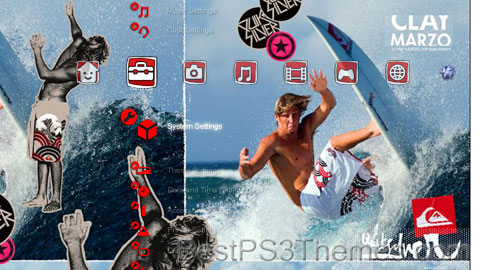
(11 backgrounds HD, 3 SD)
Quicksilver may refer to:
Home Theater theme by ShawnM
Download: HomeTheater.p3t
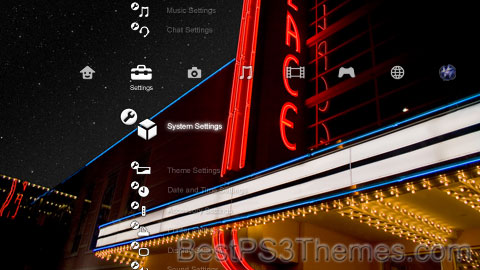
(1 background)
Redirect to:
This page is a redirect. The following categories are used to track and monitor this redirect:
|
The Palace Theater theme by ShawnM
Download: PalaceTheater.p3t
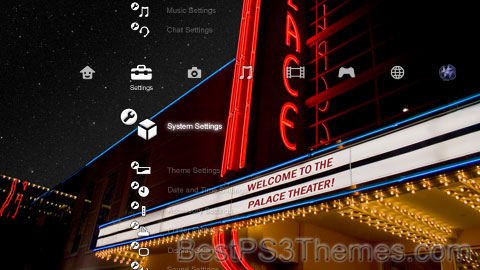
(1 background)
P3T Unpacker v0.12
Copyright (c) 2007. Anoop Menon
This program unpacks Playstation 3 Theme files (.p3t) so that you can touch-up an existing theme to your likings or use a certain wallpaper from it (as many themes have multiple). But remember, if you use content from another theme and release it, be sure to give credit!
Download for Windows: p3textractor.zip
Instructions:
Download p3textractor.zip from above. Extract the files to a folder with a program such as WinZip or WinRAR. Now there are multiple ways to extract the theme.
The first way is to simply open the p3t file with p3textractor.exe. If you don’t know how to do this, right click the p3t file and select Open With. Alternatively, open the p3t file and it will ask you to select a program to open with. Click Browse and find p3textractor.exe from where you previously extracted it to. It will open CMD and extract the theme to extracted.[filename]. After that, all you need to do for any future p3t files is open them and it will extract.
The second way is very simple. Just drag the p3t file to p3textractor.exe. It will open CMD and extract the theme to extracted.[filename].
For the third way, first put the p3t file you want to extract into the same folder as p3textractor.exe. Open CMD and browse to the folder with p3extractor.exe. Enter the following:
p3textractor filename.p3t [destination path]Replace filename with the name of the p3t file, and replace [destination path] with the name of the folder you want the files to be extracted to. A destination path is not required. By default it will extract to extracted.filename.
300 theme by myownscars
Download: 300_3.p3t
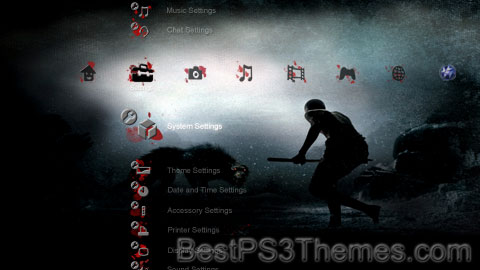
(5 backgrounds)
This article needs additional citations for verification. (April 2019) |
| Millennium: | 1st millennium |
|---|---|
| Centuries: | |
| Decades: | |
| Years: |
| 300 by topic |
|---|
| Leaders |
| Categories |
| Gregorian calendar | 300 CCC |
| Ab urbe condita | 1053 |
| Assyrian calendar | 5050 |
| Balinese saka calendar | 221–222 |
| Bengali calendar | −293 |
| Berber calendar | 1250 |
| Buddhist calendar | 844 |
| Burmese calendar | −338 |
| Byzantine calendar | 5808–5809 |
| Chinese calendar | 己未年 (Earth Goat) 2997 or 2790 — to — 庚申年 (Metal Monkey) 2998 or 2791 |
| Coptic calendar | 16–17 |
| Discordian calendar | 1466 |
| Ethiopian calendar | 292–293 |
| Hebrew calendar | 4060–4061 |
| Hindu calendars | |
| - Vikram Samvat | 356–357 |
| - Shaka Samvat | 221–222 |
| - Kali Yuga | 3400–3401 |
| Holocene calendar | 10300 |
| Iranian calendar | 322 BP – 321 BP |
| Islamic calendar | 332 BH – 331 BH |
| Javanese calendar | 180–181 |
| Julian calendar | 300 CCC |
| Korean calendar | 2633 |
| Minguo calendar | 1612 before ROC 民前1612年 |
| Nanakshahi calendar | −1168 |
| Seleucid era | 611/612 AG |
| Thai solar calendar | 842–843 |
| Tibetan calendar | 阴土羊年 (female Earth-Goat) 426 or 45 or −727 — to — 阳金猴年 (male Iron-Monkey) 427 or 46 or −726 |

Year 300 (CCC) was a leap year starting on Monday (link will display the full calendar) of the Julian calendar. At the time, it was known as the Year of the Consulship of Constantius and Valerius (or, less frequently, year 1053 Ab urbe condita). The denomination 300 for this year has been used since the early medieval period, when the Anno Domini calendar era became the prevalent method in Europe for naming years.
Final Fantasy VII theme by myownscars
Download: FinalFantasyVII_10.p3t
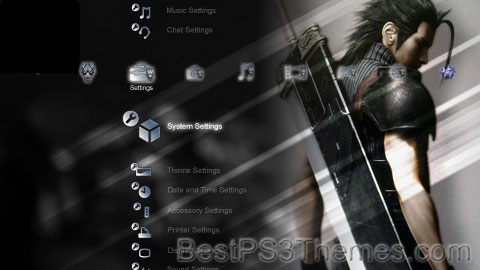
(8 backgrounds)
| Final Fantasy VII | |
|---|---|
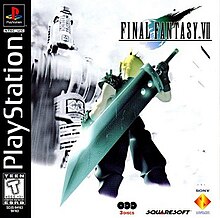 North American cover art, featuring the game's protagonist, Cloud Strife | |
| Developer(s) | Square |
| Publisher(s) |
|
| Director(s) | Yoshinori Kitase |
| Producer(s) | Hironobu Sakaguchi |
| Programmer(s) | Ken Narita |
| Artist(s) | |
| Writer(s) | Yoshinori Kitase Kazushige Nojima |
| Composer(s) | Nobuo Uematsu |
| Series | Final Fantasy |
| Platform(s) | |
| Release | January 31, 1997 |
| Genre(s) | Role-playing |
| Mode(s) | Single-player |
Final Fantasy VII[a] is a 1997 role-playing video game developed by Square for the PlayStation console and the seventh main installment in the Final Fantasy series. Square published the game in Japan, and it was released in other regions by Sony Computer Entertainment, becoming the first game in the main series to have a PAL release. The game's story follows Cloud Strife, a mercenary who joins an eco-terrorist organization to stop a world-controlling megacorporation from using the planet's life essence as an energy source. Ensuing events send Cloud and his allies in pursuit of Sephiroth, a superhuman who seeks to wound the planet and harness its healing power in order to be reborn as a god. Throughout their journey, Cloud bonds with his party members, including Aerith Gainsborough, who holds the secret to saving their world.
Development began in 1994, originally for the Super Nintendo Entertainment System. After delays and technical difficulties from experimenting with several platforms, most notably the Nintendo 64, Square moved production to the PlayStation, largely due to the advantages of the CD-ROM format. Veteran Final Fantasy staff returned, including series creator and producer Hironobu Sakaguchi, director Yoshinori Kitase, and composer Nobuo Uematsu. The title was the first in the series to use full motion video and 3D computer graphics, featuring 3D character models superimposed over 2D pre-rendered backgrounds. Although the gameplay remained mostly unchanged from previous entries, Final Fantasy VII introduced more widespread science fiction elements and a more realistic presentation. The combined development and marketing budget amounted to approximately US$80 million.
Final Fantasy VII received widespread commercial and critical success and remains widely regarded as a landmark title, and it is regarded as one of the greatest and most influential video games ever made. The title won numerous Game of the Year awards and was acknowledged for boosting the sales of the PlayStation and popularizing Japanese role-playing games worldwide. Critics praised its graphics, gameplay, music, and story, although some criticism was directed towards the original English localization. Its success has led to enhanced ports on various platforms, a multimedia subseries called the Compilation of Final Fantasy VII, and a high definition remake trilogy currently comprising Final Fantasy VII Remake (2020), and Final Fantasy VII Rebirth (2024).
The gameplay of Final Fantasy VII is similar to earlier Final Fantasy titles and Japanese role-playing games.[1] The game features three modes of play: the world map, the field, and the battle screen.[2][3]: 15, 20 At its grandest scale, players explore the world of Final Fantasy VII on a 3D world map.[4] The world map contains representations of areas for the player to enter, including towns, environments, and ruins.[5] Natural barriers—such as mountains, deserts, and bodies of water—block access by foot to some areas; as the game progresses, the player receives vehicles that help traverse these obstacles.[3]: 44 Chocobos can be found in certain spots on the map, and if caught, can be ridden to areas inaccessible on foot or by vehicle.[3]: 46 In field mode, the player navigates fully scaled versions of the areas represented on the world map.[4] VII marks the first time in the series that the mode is represented in a three-dimensional space. In this mode, the player can explore the environment, talk with characters, advance the story, and initiate event games.[3]: 15 Event games are short minigames that use special control functions and are often tied to the story.[3]: 18 While in field mode, the player can also find shops and inns. Shops allow the player to buy and sell items that can aid Cloud and his party, such as weapons, armor, and accessories. Inns restore the hit points and mana points of characters who rest at them and cure abnormalities contracted during battles.[3]: 17

At random intervals on the world map and in field mode, and at specific moments in the story, the game will enter the battle screen, which places the player characters on one side and the enemies on the other. It employs an "Active Time Battle" (ATB) system, in which the characters exchange moves until one side is defeated.[1][2] The damage or healing dealt by either side is quantified on screen. Characters have several statistics that determine their effectiveness in battle; for example, hit points determine how much damage they can take, and magic determines how much damage they can inflict with spells. Each character on the screen has a time gauge; when a character's gauge is full, the player can input a command for them. The commands change as the game progresses, and are dependent on the characters in the player's party and their equipment. Commands include attacking with a weapon, casting magic, using items, summoning monsters, and other actions that either damage the enemy or aid the player characters. Final Fantasy VII also features powerful, character-specific commands called Limit Breaks, which can be used only after a special gauge is charged by taking enemy attacks. After being attacked, characters can be afflicted by one or more abnormal "statuses", such as poison or paralysis. These statuses and their adverse effects can be removed by special items or abilities or by resting at an inn. Once all enemies are defeated, the battle ends and the player is rewarded with money, items, and experience points. If the player is defeated, it is game over and the game must be loaded to the last save point.[3]: 20–27
When not in battle, the player can use the menu screen, where they can review each character's status and statistics, use items and abilities, change equipment, save the game when on the world map or at a save point, and manage orbs called Materia. Materia are the main method of customizing characters in Final Fantasy VII, and can be added to equipment to provide characters with new magic spells, monsters to summon, commands, statistical upgrades, and other benefits.[6] Materia level up through their own experience point system and can be combined to create different effects.[3]: 30–42
Final Fantasy VII takes place on a world referred to in-game as the "Planet" and retroactively named "Gaia".[7][8] The planet's lifeforce, called the Lifestream, is a flow of spiritual energy that gives life to everything on the Planet; its processed form is known as "Mako".[9] On a societal and technological level, the game has been defined as an industrial or post-industrial science fiction setting.[10] During Final Fantasy VII, the Shinra Electric Power Company, a world-dominating megacorporation headquartered in the city of Midgar, is draining the Planet's Lifestream for energy, weakening the Planet and threatening its existence and all life.[11] Significant factions within the game include AVALANCHE, an eco-terrorist group seeking Shinra's downfall so the Planet can recover;[8] the Turks, a covert branch of Shinra's security forces;[12] SOLDIER, an elite Shinra fighting force created by enhancing humans with Mako;[13] and the Cetra, a near-extinct human tribe which maintains a strong connection to the Planet and the Lifestream.[14]
The main protagonist is Cloud Strife, an aloof mercenary who claims to be a former 1st Class SOLDIER. Early on, he works with two members of AVALANCHE: Barret Wallace, its brazen but fatherly leader; and Tifa Lockhart, a shy yet nurturing martial artist and his childhood friend. During their journey, they meet Aerith Gainsborough, a carefree flower merchant and one of the last surviving Cetra;[14][15] Red XIII, an intelligent quadruped from a tribe that protects the planet;[16] Cait Sith, a fortune-telling robotic cat controlled by repentant Shinra staff member Reeve;[3][17] and Cid Highwind, a pilot whose dream of being the first human in outer space was unrealized.[18] The group can also recruit Yuffie Kisaragi, a young ninja and skilled Materia thief; and Vincent Valentine, a former Turk and victim of Shinra's experiments.[19] The game's main antagonists are Rufus Shinra, the son of President Shinra and the later leader of the Shinra Corporation;[20] Sephiroth, a former SOLDIER who reappears several years after being presumed dead;[3] and Jenova, a hostile extraterrestrial life-form who the Cetra imprisoned 2,000 years ago and who Sephiroth was created from.[21][22][23] A key character in Cloud's backstory is Zack Fair, a member of SOLDIER and Aerith's first love.[24]
AVALANCHE destroys a Shinra Mako reactor in Midgar, but an attack on another reactor goes wrong and Cloud falls into the city's slums. There, he meets Aerith and protects her from Shinra.[25][26] Meanwhile, Shinra finds AVALANCHE's base of operations and intentionally collapses part of the upper city level in retaliation for the Mako reactor being destroyed, killing many AVALANCHE members and innocent bystanders as collateral damage.[27] Aerith is also captured since Shinra believes that as a Cetra, she can potentially reveal the "Promised Land", which they believe is overflowing with Lifestream energy they can exploit.[28][29] Cloud, Barret, and Tifa rescue Aerith, and during their escape from Midgar, discover that Sephiroth murdered President Shinra despite being presumed dead five years earlier.[30] The party pursues Sephiroth across the Planet, with now-President Rufus on their trail; they are soon joined by the rest of the playable characters.
At a Cetra temple, Sephiroth reveals he intends to use a powerful magical artifact known as "Black Materia" to cast the spell "Meteor", which would have a devastating impact on the Planet. Sephiroth claims he will absorb the Lifestream as it attempts to heal the wound caused by Meteor, and become a god-like being in the process.[31] The party retrieves the Black Materia, but Sephiroth manipulates Cloud into surrendering it. Aerith departs alone to stop Sephiroth and follows him to an abandoned Cetra city. While Aerith prays to the Planet for help, Sephiroth attempts to force Cloud to kill her; after this fails, he kills her himself before fleeing, leaving the White Materia behind.[32] The party then learns of Jenova, a hostile alien lifeform who landed on the Planet two thousand years prior to the game's events. Upon arrival on the Planet, Jenova began infecting the Cetra with a virus, and they were nearly wiped out. However, a small group managed to seal away Jenova in a tomb, which Shinra later unearthed. At Nibelheim, Jenova's cells were used in experiments which led to the creation of Sephiroth.[21][32] Five years before the game's events, Sephiroth and Cloud visited Nibelheim, where Sephiroth learned of his origins and was driven insane as a result. He murdered the townspeople, and then vanished after Cloud confronted him.
At the Northern Crater, the party learns that the "Sephiroths" they have encountered are Jenova clones who the insane Shinra scientist Hojo created. Cloud confronts the real Sephiroth as he is killing his clones to reunite Jenova's cells, but is again manipulated into giving him the Black Materia. Sephiroth then taunts Cloud by showing another SOLDIER in his place in his memories of Nibelheim, suggesting that Cloud is a failed clone of Sephiroth.[33] Sephiroth summons Meteor and seals the Crater as Cloud falls into the Lifestream and Rufus captures the party.
After escaping Shinra, the party discovers Cloud at an island hospital in a catatonic state from Mako poisoning, and Tifa decides to stay as his caretaker. When a planetary defense force called Weapon attacks the island, the two fall into the Lifestream,[34] where Tifa helps Cloud reconstruct his memories. Cloud was a mere infantryman who was never accepted into SOLDIER; the SOLDIER in his memories was his friend Zack. At Nibelheim, Cloud ambushed and wounded Sephiroth after the latter's mental breakdown, but Jenova preserved Sephiroth's life. Hojo experimented on Cloud and Zack for four years, injecting them with Jenova's cells and Mako. They managed to escape, but Zack was killed in the process. The trauma of these events triggered an identity crisis in Cloud, and he constructed a false persona based around Zack's stories and his own fantasies.[32][35] Cloud accepts his past and reunites with the party, who learn that Aerith's prayer to the Planet had been successful: the Planet had attempted to summon Holy to prevent Meteor's impact, but Sephiroth prevented it from having any effect.
Shinra fails to destroy Meteor, but manages to defeat a Weapon and puncture the Northern Crater, seemingly killing Rufus and several other personnel. After killing Hojo, who is revealed to be Sephiroth's biological father,[21] the party descends to the Planet's core through the opening in the Northern Crater and defeats both Jenova and Sephiroth. The party escapes and Holy is summoned once again, destroying Meteor with help from the Lifestream.[36] Five hundred years later, Red XIII is seen with two cubs looking out over the ruins of Midgar, which are now covered in greenery, showing that the planet has healed.
Initial concept talks for Final Fantasy VII began in 1994 at Square studio, following the completion of Final Fantasy VI. As with the previous installment, series creator Hironobu Sakaguchi reduced his role to producer and granted others a more active role in development: these included Yoshinori Kitase, one of the directors of FFVI. The next installment was planned as a 2D game for Nintendo's Super Nintendo Entertainment System (Super NES). After creating an early 2D prototype of it, the team postponed development to help finish Chrono Trigger.[37] Once Chrono Trigger was completed, the team resumed discussions for Final Fantasy VII in 1995.[37][38]
The team discussed continuing the 2D strategy, which would have been the safe and immediate path just prior to the imminent industry shift toward 3D gaming; such a change would require radical new development models.[37] The team decided to take the riskier option and make a 3D game on new generation hardware but had yet to choose between the cartridge-based Nintendo 64 or the CD-ROM-based PlayStation from Sony Computer Entertainment.[37] The team also considered the Sega Saturn console and Microsoft Windows.[39] Their decision was influenced by two factors: a highly successful tech demo based on Final Fantasy VI using the new Softimage 3D software, and the escalating price of cartridge-based games, which was limiting Square's audience.[37][40][41] Tests were made for a Nintendo 64 version, which would use the planned 64DD peripheral despite the lack of 64DD development kits and the prototype device's changing hardware specifications. This version was discarded during early testing, as the 2000 polygons needed to render the Behemoth monster placed excessive strain on the Nintendo 64 hardware, causing a low frame rate.[37] It would have required an estimated thirty 64DD discs to run Final Fantasy VII properly with the data compression methods of the day.[42] Faced with both technical and economic issues on Nintendo's current hardware, and impressed by the increased storage capacity of CD-ROM when compared to the Nintendo 64 cartridge, Square shifted development of Final Fantasy VII, and all other planned projects, onto the PlayStation.[37]
In contrast to the visuals and audio, the overall gameplay system remained mostly unchanged from Final Fantasy V and VI, but with an emphasis on player control.[43] The initial decision was for battles to feature shifting camera angles. Battle arenas had a lower polygon count than field areas, which made creating distinctive features more difficult.[40] The summon sequences benefited strongly from the switch to the cinematic style, as the team had struggled to portray their scale using 2D graphics.[44] In his role as producer, Sakaguchi placed much of his effort into developing the battle system.[24] He proposed the Materia system as a way to provide more character customization than previous Final Fantasy games: battles no longer revolved around characters with innate skills and roles in battle, as Materia could be reconfigured between battles.[40] Artist Tetsuya Nomura also contributed to the gameplay; he designed the Limit Break system as an evolution of the Desperation Attacks used in Final Fantasy VI. The Limit Breaks served a purpose in gameplay while also evoking each character's personality in battle.[24][40]
Square retained the passion-based game development approach from their earlier projects, but now had the resources and ambition to create the game they wanted. This was because they had extensive capital from their earlier commercial successes, which meant they could focus on quality and scale rather than obsessing over and working around their budget.[37] Final Fantasy VII was at the time one of the most expensive video game projects ever, costing an estimated US$40 million, which adjusted for inflation came to $61 million in 2017.[37][45][46] Development of the final version took a staff of between 100 and 150 people just over a year to complete. As video game development teams were usually only 20 people, the game had what was described as the largest development team of any game up to that point.[37][44] The development team was split between both Square's Japanese offices and its new American office in Los Angeles; the American team worked primarily on city backgrounds.[42]

The game's art director was Yusuke Naora, who had previously worked as a designer for Final Fantasy VI. With the switch into 3D, Naora realized that he needed to relearn drawing, as 3D visuals require a very different approach than 2D. With the massive scale and scope of the project, Naora was granted a team devoted entirely to the game's visual design. The department's duties included illustration, modeling of 3D characters, texturing, the creation of environments, visual effects, and animation.[47] The Shinra logo, which incorporated a kanji symbol, was drawn by Naora personally.[48] Promotional artwork, in addition to the logo artwork, was created by Yoshitaka Amano, an artist whose association with the series went back to its inception.[49] While he had taken a prominent role in earlier entries, Amano was unable to do so for Final Fantasy VII, due to commitments at overseas exhibitions.[8][49] His logo artwork was based on Meteor: when he saw images of Meteor, he was not sure how to turn it into suitable artwork. In the end, he created multiple variations of the image and asked staff to choose which they preferred.[50] The green coloring represents the predominant lighting in Midgar and the color of the Lifestream, while the blue reflected the ecological themes present in the story. Its coloring directly influenced the general coloring of the game's environments.[47]
Another prominent artist was Nomura. Having impressed Sakaguchi with his proposed ideas, which were handwritten and illustrated rather than simply typed on a PC, Nomura was brought on as main character designer.[24] Nomura stated that when he was brought on, the main scenario had not been completed, but he "went along like, 'I guess first off you need a hero and a heroine', and from there drew the designs while thinking up details about the characters. After [he'd] done the hero and heroine, [he] carried on drawing by thinking what kind of characters would be interesting to have. When [he] handed over the designs [he'd] tell people the character details [he'd] thought up, or write them down on a separate sheet of paper".[51] Something that could not be carried over from earlier titles was the chibi sprite art, as that would not fit with the new graphical direction. Naora, in his role as an assistant character designer and art director, helped adjust each character's appearance so the actions they performed were believable. When designing Cloud and Sephiroth, Nomura was influenced by his view of their rivalry mirroring the legendary animosity between Miyamoto Musashi and Sasaki Kojirō, with Cloud and Sephiroth being Musashi and Kojirō respectively. Sephiroth's look was defined as "kakkoii", a Japanese term combining good looks with coolness.[40] Several of Nomura's designs evolved substantially during development. Cloud's original design of slicked-back black hair with no spikes was intended to save polygons and contrast with Sephiroth's long, flowing silver hair. However, Nomura feared that such masculinity could prove unpopular with fans, so he redesigned Cloud to feature a shock of spiky, bright blond hair. Vincent's occupation changed from researcher to detective to chemist, and finally to a former Turk with a tragic past.[8][24]
Sakaguchi was responsible for writing the initial plot, which was quite different from the final version.[52] In this draft for the planned SNES version, the game's setting was envisioned as New York City in 1999. Similar to the final story, the main characters were part of an organization trying to destroy Mako reactors, but they were pursued by a hot-blooded detective named Joe. The main characters would eventually blow up the city. An early version of the Lifestream concept was present at this stage.[37][41][52] According to Sakaguchi, his mother had died while Final Fantasy III was being developed, and choosing life as a theme helped him cope with her passing in a rational and analytical manner.[44] Square eventually used the New York setting in Parasite Eve (1998).[41] While the planned concept was dropped, Final Fantasy VII still marked a drastic shift in setting from previous entries, dropping the Medieval fantasy elements in favor of a world that was "ambiguously futuristic".[53]